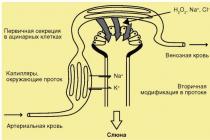Few people know that on October 8, 1950, two fighter-bombers of the US Air Force crossed the Soviet border, went deep to a distance of about one hundred kilometers, and struck the Sukhaya Rechka military field airfield.
June 25, 1950 a military conflict began between North and South Korea. Volunteer units from the PRC fought on the side of North Korea; the USSR provided financial support and supply with weapons and military advisers. The grouping of South Korea included the Americans, Great Britain and a number of other countries that were part of the UN peacekeeping force.
Although the Soviet Union did not officially participate in hostilities, it was not without armed clashes.
June 26, 1950 South Korean ships fired at the Plastun ship, which was part of the 5th Navy, as a result of which the ship's commander, Lieutenant-Commander Kolesnikov, died. Some of the crew members were injured. The enemy withdrew only after returning fire was opened.
September 4, 1950 an unidentified destroyer approached the Dalny port. An A-20Zh reconnaissance aircraft was raised into the air, accompanied by two fighters. When approaching the target, 11 American fighters attacked them at once. A-20ZH was shot down and fell into the sea. The crew was killed.
October 8, 1950 it was Sunday. Residents of the surrounding villages rested on the sea, the Sukhaya Rechka field airfield lived on a weekend schedule. For the exercise, Po-2 air spotters and Kingcobra piston fighters were relocated to it. A total of about 20 aircraft, which stood near the runway in a slender line.
At five o'clock in the evening, the silence of the peaceful sky was ripped apart by the sound of jet engines. Two American Lockheed F-80C fighter-bomber aircraft passed over the airfield and, making a combat turn, attacked the aircraft standing on the ground. One of the planes burned down completely, and seven were damaged. According to official figures, there were no casualties.
Chasing jets in piston fighters was unrealistic.
On October 9, the USSR submitted an official note of protest to the UN. The government of the Soviet Union was deeply concerned. They could not understand - either this is the beginning of the third world war, or the pilots' mistake.
On October 20, US President Harry Truman, speaking at the UN, pleaded guilty to the United States and expressed regret that the American armed forces were implicated in an incident with a violation of the USSR border and damage to Soviet property. He said that the regiment commander had been dismissed and the pilots were handed over to the military tribunal.
Despite the fact that the incident seemed settled, the 303rd Aviation Division, which had MIG-15 rocket-propelled guns, was immediately relocated from the Moscow region to the Far East. The troops entered combat duty. The situation in the units was alarming.
According to V. Zabelin, a former pilot of the 821st Aviation Regiment, there could be no mistake. The Americans should have seen perfectly well where they are flying and what they are bombing. This was a clear provocation. Zabelin also remembered that both the commander of the fighter regiment, Colonel Savelyev, and his deputy, Lieutenant Colonel Vinogradov, after the bombing, were put on trial and demoted. For not being able to fight back the Americans.
The Americans continued to defend the version of pilot error until 1990. One of the pilots who bombed the Soviet airfield, Alton Kwonbek, claimed that low clouds and strong winds were to blame.
According to Lieutenant General Georgy Lobov, who commanded the 64th Aviation Corps at that time, now deceased, there was no low cloud cover over the Sukhaya Rechka airfield. On the contrary, the day was sunny and cloudless. There could be no question of the Americans losing their bearings. If the Americans were mistaken and lost their bearings, then they should have realized their mistake even when approaching the Pacific coast. By its outline. The further track record of Alton Kwonbeck also raises doubts about the mistake. He's very successful. Most likely, the bombing was carried out on purpose, and the incident was a pure provocation by the United States.
Of course, seven aircraft for a superpower is not a great loss. There were no casualties. If a
believe the official statement. Only it is not clear then where the monument at number 106 came from in the Khasansky district of the Primorsky Territory, which is listed as "a common unmarked grave of pilots who died in the repulsion of American bombers in 1950." It is located near the village of Perevoznoye. This is the former territory of the military town Sukhaya Rechka.
Did you know that in October 1950, four US attack aircraft ... bombed five of our air bases 30 kilometers from Vladivostok with impunity, destroying or damaging, according to some sources, 7, and according to others ... 103 Soviet military aircraft? How did they kill ... Stalin, and to whom did Kaganovich and Mikoyan brag about it? Do you know that the "doctors' case" was initiated not by Stalin, but by his entourage in order to replace the doctors serving the Kremlin with further poisoning of the "leader of the people" with a poison based on hydrocyanic acid? Why was Churchill given a ride in the elections in May 1945, while the behind-the-scenes "elite" of Great Britain did not at all consider him a winner in the war?
Did Gorbachev initially want to destroy the USSR, and why can 1988 be compared to 1941 in destructiveness? Whose "sons" were the owners of the first cooperatives in the state. enterprises, and how did they make the first big money? Why did Gorbachev receive $ 200,000 in checks from South Korean President Ro Dae Woo?
ABOUT HOW THE US BOMBED OUR COUNTRY ON OCTOBER 8, 1950
66 years ago, on October 8, 1950, the Americans attacked the territory of the USSR, destroying with bombs the Soviet airfield "Sukhaya Rechka", which was located in the Khasansky district of Primorskoye near the Far Eastern village of Perevoznoye. This bombing of our territory by the US Air Force still remains unpunished, moreover, practically no one knows about it either in Russia or in the former republics of the USSR.
October 8, 1950 at 4:17 pm local time, two Lockheed F-80C "Shooting Star" ("Meteor") US Air Force fighters violated the state border of the USSR and, going deeper by almost 100 km, attacked the Soviet military field airfield Sukhaya Rechka 165 km from Vladivostok, in the Khasan region. As a result of the bombardment by US Air Force planes, seven planes of the Soviet squadron were damaged in the parking lot, one was completely destroyed.
That autumn, the war on the Korean Peninsula was already raging. Volleys roared very close to our common state border with the Koreans. In addition, the Americans and their allies did not stand on ceremony with respect to international law. Combat aircraft of the potential enemy made systematic flights near Soviet cities and military bases. Although the USSR did not officially participate in the war, it came to armed clashes.
This was the military-political background at that time in the Far East. It is not surprising that the units and formations of the Soviet Armed Forces in those parts were in constant tension. Alarms, orders for immediate dispersal followed one after another. On October 7, 1950, this was exactly the same one that came to the 821st Fighter Aviation Regiment of the 190th Fighter Air Division, armed with old American piston-carrying Kingcobras, obtained under Lend-Lease during the Great Patriotic War. The pilots had to urgently fly to the field airfield of the Pacific Fleet Sukhaya Rechka in the Khasansky region of the Primorsky Territory, 100 kilometers from the Soviet-Korean border.
At the end of 1950, in connection with the Korean War, exercises began to be held in Primorye with the redeployment of units to field airfields. The Sukhaya Rechka field airfield belonged to the Pacific Fleet aviation. There were already Po-2 spotters of a separate air squadron, intended for air cover and adjusting the fire of 130 mm naval tower batteries of the Khasan sector of coastal defense. According to the exercise plan, the Kingcobra of the 821st Fighter Aviation Regiment of the 190th Fighter Aviation Division arrived here for temporary deployment. All planes were parked in open parking along the runway, lined up in a line, which was subjected to an assault by the Americans.
At the time of the attack of the airfield, the regiment commander, Colonel V.I. Savelyev was not at the airfield, he was in the ground forces with the chief of staff of the air corps, to organize interaction for the period of the exercises. Instead of him, the deputy regiment commander, Lieutenant Colonel N.S. Vinogradov, who, instead of giving a signal to the duty officer of the 1st air squadron, dropped the pilots from the planes. Colonel Savelyev and Lieutenant Colonel Vinogradov were put on trial and demoted by a court of officer's honor for "poor education of the regiment's personnel."
... By the morning of October 8, all three squadrons of the regiment were already at their new location. Then something almost incredible began.
On Sunday, at 4:17 pm local time, two American jet planes suddenly appeared over Sukhaya Rechka. The Americans, who are barely visible from the ground - they were walking high enough - suddenly descend sharply, literally on low level flight they lay a bend over the airfield, open fire and drop four bombs.

One Soviet plane explodes. Another turn - and "Meteora" start firing from machine guns. Seven more of our cars were hit. Having shot all the ammunition within a few minutes, the Americans calmly fly away. There was no chase: it was pointless to chase the jet "Meteors" on the unharmed Po-2 "maize" or piston "Kingcobras". Half of our 20 aircraft survived.
In the summer of 1950, the Korean War broke out between the North and South. The South was supported by the UN forces led by the Americans, while the Russians and Chinese were on the side of the North. In late 1950, the Americans replaced all of their F-51s with Lockheed F-80Cs, which became the main fighter-bombers of the US Air Force in Korea. From September 28 to October 1, 1950, F-80s flew from Japan to the South Korean Daegu airbase. The 49th FBG (Fighter and Bomber Squadron) became the first unit on the Korean peninsula to be fully armed with jet fighters.
In November, this group fought as part of the temporary 6149th tactical support wing, which was specially created on September 5. Her motto was "Protect and revenge." On November 8, four single-seat F-80s, each equipped with six 12.7 mm machine guns and 1,800 rounds of ammunition, 2 bombs and 10 missiles, flew from the Daegu base to the north ...
“It was a day off. Everyone rested at sea, and then they arrived. They circled, fired machine guns at the planes and disappeared behind the hills. I was already 13 years old then, ”recalled a resident of the village of Sukhaya Rechka, Grigory Boldusov, who still lives there.
It is very important that for several decades, both American pilots who participated in the air raid on the USSR, wingman Allen Diefendorf and host Alton Kwonbek, in their defense, insisted that they had lost their course due to bad weather and shot the airfield by mistake.

The weather, as already mentioned, was wonderful that day. On the fuselages of Soviet aircraft, characteristic marks were clearly visible, which had nothing to do with the "plumage" of Korean fighters. The Americans knew perfectly well who they were bombing. By the way, Kwonbek was already working for the CIA in those years. Subsequently, after retiring from aviation, he worked on the Senate Intelligence Committee, retired and is now farming on his farm in Middelburg. Kwonbek said that another pilot, Allen Diefendorf, died in 1996 after 33 years in the Air Force. “The Russians did not have ready aircraft or missiles to repel our attack. It was Sunday afternoon. It was like Pearl Harbor for them, ”Kwonbek wrote cynically in his memoirs.
“There was a war in Korea. Soviet meteorological data were classified, which deprived us of information about the weather in Siberia and the Far East, - Kwonbek recalled. - Identification marks on the ground were not visible, radio navigation did not exist. Calculations were made only on the basis of the direction and strength of the wind, and the flight time to the target determined the need for a descent. The flight took place above the clouds at an altitude of over 11 thousand meters. At an altitude of 3 thousand meters in the clouds, I found a hole, we rushed into it and found ourselves above a wide river valley ... I did not know exactly where we are ... A truck was going west along the dusty road. "
The Americans decided to catch up with the truck and, pursuing the car, went to the airfield. It looked like the Chongjin airfield that the pilots saw on a large-scale map. “Soviet radars must have tracked us about 100 miles from the border. Following our descent, they probably lost us in the folds of the terrain as we descended into the river valley. A general alert was issued, but the Russians had no aircraft or missiles ready to repel the attack.
It was Sunday afternoon. There were many planes at the airfield - the dream of any military pilot. About 20 aircraft of the R-39 and R-63 types were lined up in two rows ... On the dark green fuselages were large red stars with a white rim. There was almost no time to make decisions, the fuel was also running out ... I entered on the left, fired several bursts, my partner Allen Diefendorf did as I did. " After making sure that the target was hit, the Meteors turned and flew away. On departure from the target, the Americans headed for the base and suddenly saw an island near the coast. Wow, I thought, Kwonbek recalled. "There is no island near Chongjin ..."
A little worried and checking the map, the Americans decided that they had struck another North Korean airfield. Returning, the pilots reported that they had bombed the airfield with planes. Experts checked the aircraft's camera recording, and it turned out that the planes at the airfield were American Kingcobras, supplied by the Americans to the Russians under a lend-lease. The camera showed that the planes on the ground did not flare - probably there was no fuel, which means that it was definitely not a military airfield of the North Koreans and the pilots were mistaken.
Lieutenant-General Lobov, commander of the 64th Aviation Corps at that time, is sent a report on the dead - the Americans killed almost a quarter of the people who remained at the airfield that day. Several officers went on leave - this saved their lives. And some of the officers were visited by girlfriends from the neighboring Slavyanka - they were later taken to be buried in the regional center.
The report on the dead was sent to Moscow, the night of October 9 falls. A long night, during which no one slept at the airfield. Everyone was waiting for the next raid. The next morning, without receiving any directives from the capital, General Lobov announces an order: to consider the air strike as the beginning of the Third World War. Bring all formations to full combat readiness. Why did the general give such an order without waiting for directives from Moscow? Perhaps he just lost his nerves, it turned out that the raid was not the first attack of the Americans. Just few people knew about it then.
On October 9, the USSR submitted an official note of protest to the UN. The government of the Soviet Union was deeply concerned. They could not understand - either this is the beginning of the third world war, or the pilots' mistake.
On October 20, US President Harry Truman, speaking at the UN, pleaded guilty to the United States and expressed regret that the American armed forces were implicated in an incident with a violation of the USSR border and damage to Soviet property. He stated that the regiment commander was dismissed, and the pilots were transferred to a military tribunal, that the attack on the territory of the Soviet Union was "the result of a navigational error and poor calculation" of the pilots. And also - that the commander of the aviation unit, which included the F-80, was removed from office, disciplinary sanctions were imposed on the pilots.
Despite the fact that the incident seemed settled, the 303rd Aviation Division, which had MIG-15 rocket-propelled guns, was immediately relocated from the Moscow region to the Far East. The troops entered combat duty. The situation in the units was alarming. Everything was ready for the outbreak of World War III ...
Of course, the Americans carefully prepared an air strike on the USSR for several months. To do this, several of the newest jet "Lockheeds" were transferred from Japan to the South Korean base of Daegu - earlier, only piston F-51s were located at the base. Initially, four crews were supposed to bomb the Soviet village, but on the morning of October 8, two Meteors suddenly showed breakdowns. And the mechanics, who had studied these machines well, did not have time to bring them to the base. Two pilots had to fly - Kwonbek and Diefendorf ...
The Americans continued to defend the version of pilot error until 1990.
In the opinion of Lieutenant General Georgy Lobov, who commanded the 64th Aviation Corps at that time, and V. Zabelin, a former pilot of the 821st Aviation Regiment, there could be no mistake. The Americans should have seen perfectly well where they are flying and what they are bombing. This was a clear provocation. According to Zabelin, “the Americans saw very well where they were going. We flew 100 kilometers from our border with Korea. They knew everything perfectly. It was invented that the young pilots got lost. " Most likely, the bombing was carried out on purpose, and the incident was a pure provocation from the United States.
However, in any case, this is not the only secret of those events. The archival documents of the Ministry of Defense and the Ministry of Foreign Affairs of the USSR speak only of Soviet planes broken and damaged as a result of a sudden attack. And not a word - about human losses.
“After this incident, the 64th Aviation Corps was urgently created and began to prepare for rearmament,” recalled Nikolai Zabelin, pilot of the 821st Regiment. - After the attack, combat duty was also introduced in the regiments. This has not happened since the end of World War II. We sat from dawn to dawn in the cabins and around. There was a feeling of an imminent war ... "
In the list of monuments in the Khasansky District of Primorsky Territory, number 106 is "a common unmarked grave of pilots who died while repelling American bombers in 1950". It also indicates that the grave is located near the village of Perevoznoye, the former territory of the military town of Sukhaya Rechka.
It is strange, of course, that the grave is nameless. It is strange that the military archives are silent about her. Here and in the Great Patriotic War, the fallen were buried wherever and at random, not caring about the mark on the map. Then they said that there were allegedly no casualties during this bombing - only military equipment suffered. But no one can say for sure how many victims are in the grave. Someone says -10 people, and someone - more than two dozen.
In a secret for half a century, a report addressed to the commander of the 64th Aviation Corps, Lieutenant General Georgy Lobov, reported 27 deaths as a result of the same airstrike. Residents of Perevoznoye say that not everyone was buried in a mass grave at that time - the bodies of several civilian employees were taken to the regional center, to Slavyanka.
Today, several dozen people live in the village of Perevoznoye. In the cemetery, where the victims of the American air raid were laid to rest, the graves are more or less well-groomed - a few residents still keep the memory of the victims.
Based on materials: blagogon.ru and topwar.ru
Evgeny SHOLOKH
The insolence of the United States, considering itself "masters of the world" after the collapse of the USSR, and unleashing aggression against Iraq, in general, probably did not surprise anyone. However, few people know that the impudence of the Americans literally had no boundaries and half a century ago in relation to the USSR. Until we sobered them. Rockets ...
Our sky was like a courtyard ...
After World War II, the recent allies in the anti-Hitler coalition, the Americans, became impudent and began to completely ignore our air borders. The United States sent dozens of their reconnaissance aircraft into Soviet airspace, turning our sky into a gateway. We then had nothing to "adequately answer" the impudent ones: the American "B-29", "B-52", "V-47" and "RV-47" with a very large "ceiling" of flight altitudes were inaccessible for Soviet air defense systems, not which were then still in service with long-range anti-aircraft missiles.
Judging by the documents we have, in the 50s. the Americans managed to hang out with impunity in the airspace in the area of \u200b\u200bMoscow, Leningrad, the Baltic States, Kiev, Minsk, Murmansk, Arkhangelsk, the Soviet Far East - Primorye, Khabarovsk, Sakhalin, Kuril Islands, Kamchatka ...
And it happened that they did not just wander in the air, wherever they hit, satisfying their espionage curiosity, but also attacked our military facilities. So, on October 8, 1950, two US Air Force "F-80" "Meteor" aircraft not only flew into the territory of the Soviet Primorye, but also suddenly attacked the airfield of the Pacific Fleet Air Force near the village of Sukhaya Rechka, located in the Khasan region, as a result of which seven our planes! As a participant in the Korean War, air defense fighter pilot, retired aviation colonel Sergei Tyurin recalled: "Until we received the go-ahead for interception, these vultures, presumably, were already drinking beer in Seoul ..."
It even got to the point that the Yankees, having invaded our airspace, were demonstratively practicing a nuclear strike against ground targets of the Soviet Union. This is exactly what happened on April 29, 1954 on the Kiev-Smolensk-Novgorod line, when several dozen US Air Force aircraft played great on the nerves of the Soviet military-political leadership ...
In connection with all these facts, the leadership of the USSR on May 27, 1954 was forced to adopt a resolution "On unpunished flights of foreign aircraft over the territory of the USSR", which set a tough task for special design bureaus to quickly create the necessary means of counteracting the presumptuous Americans.
"Neptune" was sent to the bottom
According to some reports, the first time we managed to do this on April 8, 1950 in the Baltic. The US Air Force B-29 violated the border in the Liepaja area and invaded our territory for 21 km. Soviet fighters intercepted him and ordered him to follow them to land at the airfield. However, the B-52 opened fire and tried to escape. This predetermined his future fate: the downed American fell into the Baltic Sea. Of the 10 crew members, the search group managed to pick up only one alive ...
On November 6, 1951, during a reconnaissance mission over the Sea of \u200b\u200bJapan, a US Navy P2V "Neptune" aircraft was shot down by a Soviet fighter from the American naval base in Japan Atsugi. What became of the Neptune crew is unknown to this day. And on the afternoon of November 18, 1951, 30 km south of Cape Gamow in the Peter the Great Bay, an air battle took place between four Soviet MiG-15 fighters and a group of US Air Force F-9 fighters. There is still conflicting information about this clash. However, it is known that as a result of this skirmish, three MiGs did not return home: one crashed and fell into the sea at Cape Lev, two others were shot down near Furugelm Island (both were discovered and raised). One of our pilots managed to jump out with a parachute, but he was never found dead or alive. The Americans were lucky then: only one of their aircraft was damaged.
On June 13, 1952, during a reconnaissance flight over the Sea of \u200b\u200bJapan, our fighter shot down an RB-29 US Air Force from the 91st Strategic Reconnaissance Squadron (from the Yokoto base, Japan). The fate of 12 of its crew members remains unknown.
On October 7, 1952, our MiG managed to shoot down another RB-29 American reconnaissance aircraft from the same 91 Squadron near the Kuriles. Out of 8 crew members, our search and rescue forces found only the lifeless body of US Air Force Captain John Donham, which was buried by Soviet border guards on the Kuril island of Yuri (in 1994, his remains were exhumed by the American side and reburied at Arlington National Cemetery).
By the way, we must pay tribute to the Americans, who did everything possible to save the surviving soldiers (for example, during the war in Korea, Vietnam, they had special operational search and rescue groups that quickly found themselves in the place of a downed helicopter or Air Force aircraft USA), as well as to find the bodies of the dead by all means, establish their names and bury them with honors in their homeland. In the USSR, and even now in Russia, the living were not and are not favored, and there is no need to talk about the dead. 58 years have passed since the Great Patriotic War, and according to various estimates, from 800 thousand to 1.5 million soldiers who died on the battlefield defending the Fatherland from Hitler's invasion have not yet been betrayed. But the old adage says: a war cannot be considered over until the last soldier is buried, as expected.
Early in the morning of July 29, 1953, the Pacific Fleet's radar station, 130 miles south of Cape Gamov, discovered an unknown plane heading for Vladivostok. After 12 minutes. from the airfield of the fighter-aviation regiment in Nikolaevka, two duty MiG-17 fighters piloted by the guard captain Alexander Rybakov and the guard senior lieutenant Yuri Yablonovsky were raised on alarm to intercept the foe. At 7 o'clock. 11 minutes Flight Commander A. Rybakov discovered an intruder plane over our territorial waters at a distance of 10 km to the south of Askold Island, which turned out to be an American B-50 bomber. The Yankees reacted to the signal from our pilots that they are in the airspace of the USSR and must immediately leave it, by fire, damaging A. Rybakov's MiG. Ours fired back from aircraft cannons. And at 7 o'clock. 16 minutes - after 15 minutes. after entering Soviet airspace, the US Air Force B-50 crashed into the water 8 miles south of Askold Island, where its wreckage remains at a depth of about 3,000 meters to this day. A day later, the American destroyer managed to save one of the plane's crew members - the second pilot, Lieutenant John Rogue.
Losses of Soviet aviation
We also lost aircraft during the Cold War. There are 14 of them on this black list. True, the American side, as far as we know, recognizes only two Soviet aircraft shot down by them. This is the A-20Zh bomber "Boston" (received under Lend-Lease from the United States in 1944), shot down on September 4, 1950 near the island of Khayon-dao by carrier-based fighters from the American aircraft carrier "Volley Rog" (the remains of one of the pilots Lieutenant Mishin, they returned to us in 1956). And unarmed, converted into a passenger Il-12, en route from Port Arthur to Vladivostok, and destroyed by US Air Force fighters on July 27, 1953 - on the day of the end of the war on the Korean Peninsula (there were 21 people on board, including crew members; urns with their ashes on December 18, 1953, they were interred in the public garden at the Dalzavodskaya stop in Vladivostok). The Americans deny any involvement in the death of the rest of our planes, therefore nothing is known about their fate to this day. Let's name some of them. On July 15, 1964, our Tu-16R disappeared while tracking the actions of a US Navy carrier strike group 200 miles east of Japan. On May 25, 1968, another Tu-16R, performing a reconnaissance flight in the area of \u200b\u200bthe American carrier strike group in the Norwegian Sea, suddenly caught fire and crashed into the water. The Yankees found the bodies of three of the seven pilots and handed them over to a Soviet warship. On January 10, 1978, in the region of the Japanese Islands, a Soviet Tu-95RTs aircraft with its entire crew disappeared into obscurity ...
Rockets opened an account ...
But if from time to time we managed to shoot down ordinary US Air Force planes, then we could “get” the American “ghost” - a new U-2 reconnaissance aircraft from Lockheed (built since 1956) with a small reflective surface and a ceiling height 20-25 km - we could not (the MiG-19 could not climb above 17.5 km, there were no such missiles). Meanwhile, U-2 flew with complete impunity over practically the entire territory of the Soviet Union, incl. over Moscow and Leningrad (the defense of which was considered one of the most reliable in the world), collecting the necessary intelligence information.
As part of the secret Mobi-Dick reconnaissance program, the US intelligence services also launched into Soviet airspace special high-altitude balloons equipped with automatic cameras and other spy equipment, which pilots of both the USSR and the USA often mistook for UFOs. In 1957, our anti-aircraft gunners in the Kuril Islands discovered such a balloon and even opened fire, but to no avail - the target was too high.
But there is a limit to everything. And we finally "hit". Although some of our aircraft designers, as well as other pundits, could not believe for a long time that an airplane could "hang" for hours at such an inconceivable height, and therefore tended to think, like the pilots, that it was most likely a UFO.
The events of May 1, 1960 demonstrated that anomalous phenomena or any devilry in this case had nothing to do with it. On this day, in the area of \u200b\u200bindustrial Sverdlovsk (now Yekaterinburg), stuffed with defense enterprises, a US Air Force spy plane U-2, piloted by pilot Francis Harry Powers, appeared at its unattainable height. Our anti-aircraft gunners with a missile of the new S-75 complex, finally, without much difficulty "got" it. The plane crashed to the ground. The pilot, instead of committing suicide as ordered by the instructions, chose to eject and surrender at the mercy of the victors. True, our anti-aircraft gunners then overwhelmed one more plane. Own. By mistake. Pilot Safronov was posthumously awarded the order, a closed decree. And the widow of the deceased captain was told not to talk about what happened to her husband.
Powers was tried and imprisoned, though not for long. Soon he was exchanged for our intelligence officer Colonel Rudolf Abel (Fischer), captured in the United States back in 1957.
And two months later, on July 1, 1960, over the Baltic, we shot down another aerial spy - the RV-47 aircraft, whose crew did not want to obey and land on our airfield. One crew member was killed in this case, two others - US Air Force Lieutenants D. McCone and F. Olmsted - were captured and later returned to their homeland.
So in the early 60s. the airspace of our Motherland was closed. Until he was uncorked in May 1987 by a German amateur pilot, 19-year-old Matthias Rust, who, on the Day of the Border Guard, sat in his light-engine "Cessna" right on ... Red Square in Moscow. There was a shock among the military-political leadership of the USSR. It was much more than a shame ...
The last case of confrontation in the air during the Cold War, according to our data, took place in the same 1987, September 13. NATO has conducted naval exercises in the vicinity of our northern borders. It is clear that we followed them, they followed us. The usual thing in such cases. When our Su-27 fighter, by order, made a training interception of the Norwegian P-3 Orion patrol aircraft and began to fly it over the neutral waters of the Barents Sea, the Norwegian tried with a special maneuver not only to get rid of the Soviet Sushka, but also to punish her pilot. But he did not take into account the unique technical capabilities of the Su-27, and as a result, Orion suffered himself, hitting the end of the keel of our aircraft with the propeller. The Norwegian's propeller fell, hitting the Orion's wing and fuselage with fragments, which, having smoked and giving a distress signal, barely reached its base ...
And there was a diplomatic scandal. Our pilot was accused of "amateur performance" and roughly punished for the edification of others - the Gorbachev era of "new thinking" was gaining momentum, when one after another the hard-won positions were surrendered to the mercy of the United States and political priorities began to change dramatically, as a result of which a potential enemy became partner ".
Instead of an epilogue
The tough confrontation of the Cold War seemed to have sunk into oblivion and became the property of history. There is no longer either the USSR or the socialist military bloc "Warsaw Pact". However, judging by the events in the world in recent years, the Americans are still itching to. The proclaimed "partnership" relations with Russia cannot be considered as such in full measure. US aviation, as in the old days, hangs along our borders, except perhaps just not invading Russian space, spy satellites and ground tracking stations keep vigilant watch over Russian "friends", and nuclear submarines are periodically found near naval bases of Russia in the North and in the Far East: off the coast of Kamchatka, in the Peter the Great Gulf near the island of Askold ...
On May 9, 1945, the country of the USSR celebrated the Victory over Nazi Germany. The victory was shared with other countries, such as the United States, which opened the Second Front and supplied us with goods through Land Leasing.
But already in 1946 and 1953 the USA bombed our Far East and Siberia. From the official data of the USSR Ministry of Defense, it is not clear what kind of war it was over the next 7 years. The war was covered up by the "war in Korea". But it was NOT Korea that was bombed, but us.
"According to the Central Archives of the Russian Ministry of Defense, Soviet aviation units in the Korean War lost 335 aircraft and 120 pilots. The 64th Air Fighter Corps, which took part in the Korean War, numbered 26 thousand people. According to the corps commander, Lieutenant General G.A. Lobov, our losses in air battles amounted to 335 aircraft and, according to updated data, 200 pilots. "
(See Izvestia, February 9, 1994, and Komsomolskaya Pravda, June 25, 1991.)
Every war has a purpose. Announced and secret.
What was the goal of the UNKNOWN war of 1946-1953. ?
Stalin and Budyonny during the parade stand on the Mausoleum on Red Square near the Kremlin, Moscow.
We live in a fog of myths and lies
Do we know our history? Do we remember the events that happen to us? It is unlikely that a person remembers everything that happened to him in his life. Therefore, it is also impossible to remember historical facts, especially when you are still being led in in the dark, hiding reality in the labyrinths of politics and the struggle for the enslavement of the peoples of the world by a flock of eternally hungry jackals.
We live in one place in our large country, and do not know what is happening at the other end. The country is big, but a person lives only in his own small reality.
Today there is a cold war between Russia and NATO countries, led by the United States. Living and being contemporaries of our life with you, we still do not know what is really happening around us, because many facts are hidden, as if they did not exist and did not exist.
It is no wonder that today we are discovering with you events from the past that are hard to believe. Our grandfathers and parents lived at that time, but they did not tell us everything that we learn from the archival data. But these events happened to people. Hundreds of people were witnesses. They were silent? Why? Or all witnesses to the "inconvenient" events went under liquidation, as was usually done in our society of Soviet reality.
In the 60s of the twentieth century, that is, in 1960 and beyond, uprisings broke out in Russia against the state power of the period of the General Secretary of the Party Nikita Khrushchev. The uprisings were brutally suppressed. Tanks crushed people. They were shot in the squares. If these were small settlements, then, as a rule, entire villages fell under the liquidation. If the whole city expressed dissatisfaction, then it was more difficult here. But, despite these difficulties with gagging a large mass of the population, the military took cities under siege, blocked all exits from the city, and worked through every house, every apartment for information leaks to other cities.
The puncture happened only once. In a big industrial city An uprising broke out in Novocherkassk. People were starving. Salaries were lowered. There was nothing to eat, the shops gaped with empty shelves. Slave labor could not be introduced into the post-war population when the Second World War of 1941-1945 developed among the people the desire to survive at any cost. The hands of the male population still remembered the locks of the automatic rifles. The mentality of the population was still clearly trying to divide into friend or foe.
But there were cases, egregious in their cynicism, when the "truth" did not go beyond the boundaries of hundreds of hectares of land. Because there was practically no one to tell what is hard to believe today.
For example, few people know that the United States bombed our Far East in the 1950s. Just 30 kilometers from the large city of Vladivostok, US Navy fighter jets bombed five military units.
Our allies in the war against fascism after the end of the war, five years later, unleashed a new war with the USSR, about which practically nothing is known to this day.
In October 1950, four (4) American fighters attacked the Sukhaya Rechka military unit. They bombed completely together with the civilian population around the unit.
Then, day after day, about 11 American fighters flew in from Japanese airfields and bombed our next military targets. Bombed according to official data, which is not fully known to us, 5 military units, 103 military aircraft.
And to this day the world does not know the truth about the war in the Far East on the territory of the USSR. Until now, the truth is prohibited. And only some declassified data reach us, such as an interview with Poltoranin in the Karaulov program.
Our minds are still obscured by false data about real events. The bombing of Siberia and the Far East by the Americans continued for more than one day. And it was not a surprise for us, for the USSR. In the Far East, there was a war, which for us was designated as the Korean War.
"There was a war in Korea. Soviet meteorological data were classified, which deprived us of information about the weather in Siberia and the Far East, " - recalled Kwonbek, a former employee of the CIA and the Senate Intelligence Committee, and also a former pilot of one of two American fighters that stormed Sukhaya Rechka airfield in 1950.
The former stormtrooper talks about the weather in Siberia and the Far East, not Korea. In the opinion of Lieutenant General Georgy Lobov, who commanded the 64th Aviation Corps at that time, now deceased, and the former pilot of the 821st Aviation Regiment V. Zabelin, “the Americans saw perfectly where they were flying. We flew 100 kilometers from our border with Korea. "
This is not the only secret of those events. The archival documents of the Ministry of Defense and the Ministry of Foreign Affairs of the USSR speak only of Soviet planes broken and damaged as a result of a sudden attack. And not a word - about human losses.
In the list of monuments in the Khasansky district of Primorsky Krai number 106 is “a mass unmarked grave of pilotskilled in the repulsion of American bombers in 1950 ”. It also indicates that the grave is located near the village of Perevoznoe, the former territory of the military town of Sukhaya Rechka.
It is strange, of course, that the grave is unmarked. It is strange that the military archives are silent about her. Note that the planes didn't even take off. They were driven from other regions and destroyed here. What was behind the secrets and betrayal of your people?
Combat aircraft of the potential enemy made systematic flights near Soviet cities and military bases. Although the USSR did not officially participate in the war, it came to armed clashes. But this was rare. Probably, soviet military units had treacherous orders not to return fire. Otherwise how to explain the defeat of 103 combat aircraft at our airfields?
On the night of June 26, 1950
in international waters, South Korean warships fired at the Plastun cable ship, which was part of the 5th Soviet Navy (now the Pacific Fleet), resulting in the death of the ship's commander, Lieutenant-Commander Kolesnikov. Some of the crew members were injured. The enemy withdrew only after returning fire was opened.
September 4, 1950
years to observe the actions of an unidentified destroyer that approached a distance of 26 kilometers to the port Dalny (formerly Port Arthur), [ - now it is the Chinese city of UDALYANCHI]
on alarm, the crew of the Soviet reconnaissance aircraft A-20Zh "Boston" of Senior Lieutenant Konstantin Korpayev was raised into the air. He was accompanied by two of our fighters. On the way to the goal soviet planes were immediately attacked by 11 American fighters
... As a result of a short air battle, the Boston caught fire and fell into the ocean. All three of its crew members were killed.
Units and formations of the Soviet Armed Forces in those parts were in constant tension. Alarms, orders for immediate dispersal followed one after another. October 7, 1950 this is exactly what came to the 821st Fighter Aviation Regiment of the 190th Fighter Aviation Division, armed with old American piston Kingcobras obtained under Lend-Lease during the Great Patriotic War. The pilots had to urgently fly to the field airfield of the Pacific Fleet Sukhaya Rechka in the Khasansky region of the Primorsky Territory, 100 kilometers from the Soviet-Korean border. By the morning of October 8, all three squadrons of the regiment were already at their new location. Then something almost incredible began.
Then something happened that should be called a betrayal of the interests of his people, a betrayal of the peoples of the USSR. How to understand the actions of the General Staff of the Ministry of Defense of the USSR, when THREE combat squadrons of the regiment are urgently transferred and then these squadrons of the 821st air regiment were destroyed by our adversary the United States?
On Sunday October 8, 1950 at 16 hours 17 minutes local time, two jet aircraft suddenly appeared over Sukhaya Rechka. On low level flight, they passed over the airfield, then turned around and opened fire. No one had time to understand anything, as six Soviet aircraft were damaged, and one burned down. There is not a word in the archival documents about whether there were any killed and wounded in the 821st Aviation Regiment.
I believe that not two fighters, but much more, bombed the military units that had just changed their location. They were driven closer to the border by the Soviet leadership and given up for complete destruction.
October 8, 1950 it was Sunday. Residents of the surrounding villages were resting at the sea, the field airfield Sukhaya Rechka lived on a weekend schedule. For the exercises, Po-2 air spotters and Kingcobra piston fighters were relocated to it. A total of about 20 aircraft, which stood near the runway in a slender line.
From the memories of the stoker:
- - And you know, son, our Americans navigated the irradrome once, in the fifties.
- - What are you, grandfather, there was no war here. In Korea, the Americans definitely fought, but so that they took us and swooped down on us - it can't be.
- - Very much indeed. Tuta is not always empty, as it is now, it was... There were planes before the war, and they were in the war after. During the war, they say, even an American bomber sat down here, knocked out. Fighters on the irradrome were propeller driven, yes, "maize", and when it became too small for jet, then it was abandoned. So, sometimes, the turntables fly from Nezhinka and from Sukhodol in the summer. They will arrive in May, you will see for yourself.
Here are other memories:
Sukhaya Rechka is a toponymic, conventional term. In fact, the airfield was located between the villages of Perevoznaya and the station Kedrovaya, Khasan Territory. Enough from the stadium that behind the school on Perevoznaya, walk 400 meters and the first signs of an airfield will appear.
The characteristic elongated tin plates with round holes on the fences of the houses of the surrounding villages are also echoes of that airfield.
Only on October 2, 1964, when the Cold War broke out around Cuba, the population of the USSR received some information about the Sukhaya River.
American pilots, apparently "remembering allied relations", often flew over the ships and bases of the Pacific Fleet. From the moment of the surrender of Japan until the end of 1950. was recorded 46 incidents involving 63 American aircraft of various types. Sometimes anti-aircraft gunners opened barrage and fighters rose into the air. The first air battle took place in 1945. over the territory of Korea, when four of our "Airacobras" intercepted an American B-29 bomber and, after firing at it, landed at the Hamhyn airfield, where at that time Soviet aviation was based, which had recently ended the war with Japan.
Gradually, with the change in foreign policy, random flights turned into systematic reconnaissance, and the air war broke out in earnest, reaching its climax in the 50s. So in May 1950 over the Chukchi airfield Uelkal an air battle broke out between the American "Mustangs" F-51 and the Soviet La-11, as a result of which the pilot captain S. Efremov knocked out one "Mustang", but he himself, having received damage, barely made it to the airfield.
I was born in Chukotka. My parents came to Chukotka when they were young. But we have never heard anything like that that there were battles over Chukotka.
Is the target of the war Alaska?
According to various sources, the Americans made from 800 to 1000 sorties per day. It was a real war. For what? What goals were pursued? and what happened as a result that we do not know?
Perhaps it was at this time that the Americans conquered Alaska from us, which they now present to us as sold in ancient times. Why did the Americans spend so much money on 800 flights a day? This is a lot of money! There was a war going on. About which we know nothing. What are they hiding from us? What do we not know? What was the war for in the Far East? Why did the Americans bomb our Siberia? Until now, videos about the bombed cities of Siberia are hidden and destroyed on the Internet.
Few people know that in fact, in those years, overseas aircraft nevertheless inflicted an unpunished strike on Soviet territory. It happened in the Far East in October 1950 ...
On October 8, 1950 at 4:17 pm local time, two Lockheed F-80C "Shooting Star" ("Meteor") US Air Force fighters violated the state border of the USSR and, deeper by almost 100 km, attacked the Soviet military field airfield Sukhaya Rechka 165 km from Vladivostok, in the Khasan region. As a result of the bombardment by US Air Force planes, seven planes of the Soviet squadron were damaged in the parking lot, one was completely destroyed.
That autumn, the war on the Korean Peninsula was already raging. Volleys roared very close to our common state border with the Koreans. In addition, the Americans and their allies did not stand on ceremony with respect to international law. Combat aircraft of the potential enemy made systematic flights near Soviet cities and military bases. Although the USSR did not officially participate in the war, it came to armed clashes.
On the night of June 26, 1950, in international waters, South Korean warships fired at the Plastun cable ship, which was part of the 5th Soviet Navy (now the Pacific Fleet), as a result of which the ship's commander, Lieutenant-Commander Kolesnikov, died. Some of the crew members were injured. The enemy withdrew only after returning fire was opened.
On September 4 of the same year, the crew of the Soviet reconnaissance aircraft A-20ZH "Boston", Senior Lieutenant Konstantin Korpayev, was raised by alarm to observe the actions of an unidentified destroyer that approached at a distance of 26 kilometers to the port of Dalny (formerly Port Arthur). He was accompanied by two of our fighters. On the way to the target, the Soviet planes were immediately attacked by 11 American fighters. As a result of a short air battle, the Boston caught fire and fell into the ocean. All three of its crew members were killed.
This was the military-political background at that time in the Far East. It is not surprising that the units and formations of the Soviet Armed Forces in those parts were in constant tension. Alarms, orders for immediate dispersal followed one after another. On October 7, 1950, this was exactly the same one that came to the 821st Fighter Aviation Regiment of the 190th Fighter Air Division, armed with old American piston Kingcobras, obtained under Lend-Lease during the Great Patriotic War. The pilots had to urgently fly to the field airfield of the Pacific Fleet Sukhaya Rechka in the Khasansky region of the Primorsky Territory, 100 kilometers from the Soviet-Korean border. By the morning of October 8, all three squadrons of the regiment were already at their new location. Then something almost incredible began.
On Sunday, at 4:17 pm local time, two jet planes suddenly appeared over Sukhaya Rechka. On low level flight, they passed over the airfield, then turned around and opened fire. No one had time to understand anything, as six Soviet aircraft were damaged, and one burned down. There is not a word in the archival documents about whether there were any killed and wounded in the 821st Aviation Regiment. But more on that below.
It turned out that the American F-80 Schuting Star fighters had stormed the Sukhaya River. The pilots of the 821st Aviation Regiment did not even try to chase the F-80 jet. It would have been impossible on their piston Kingcobras.
On October 9, the USSR submitted an official note of protest to the UN. The government of the Soviet Union was deeply concerned. They could not understand - either this is the beginning of the third world war, or the pilots' mistake.
On October 20, US President Harry Truman, speaking at the UN, pleaded guilty to the United States and expressed regret that the US military was implicated in an incident involving the violation of the USSR border and damage to Soviet property. He stated that the regiment commander was dismissed, and the pilots were transferred to the court of the military tribunal, that attack on the territory of the Soviet Union was the "result of navigation error and poor calculation" of the pilots. And also - that the commander of the aviation unit, which included the F-80, was removed from his post, disciplinary sanctions were imposed on the pilots.
Despite the fact that the incident seemed settled, the 303rd Aviation Division, which had MIG-15 rocket-propelled guns, was immediately relocated from the Moscow region to the Far East. The troops entered combat duty. The situation in the units was alarming.
The Americans continued to defend the version of the pilot error until 1990.

"There was a war in Korea. Soviet meteorological data were classified, which deprived us of information about the weather in Siberia and the Far East, - recalled Kwonbek, a former employee of the CIA and the Senate Intelligence Committee, and also a former pilot of one of two American fighters that stormed Sukhaya Rechka airfield in 1950. - There were no identification marks on the ground, radio navigation did not exist ... At an altitude of 3 thousand meters in the clouds, I found a gap, we rushed into it and found ourselves above a wide river valley ... I did not know exactly where we are .. There was a truck going west along the dusty road. "
The Americans decided to catch up with the truck and, pursuing the car, went to the airfield. It looked like the Chongjin airfield that the pilots saw on a large-scale map.
"Soviet radars must have tracked us about 100 miles from the border. Following our descent, they probably lost us in the folds of the terrain as we descended into the river valley. A general alert was issued, but the Russians did not have planes or missiles ready to repel an attack.It was Sunday afternoon. There were many planes at the airfield - the dream of any military pilot. About 20 R-39 and R-63 aircraft were lined up in two rows ... On the dark green fuselages were large red stars with a white rim. There was almost no time to make decisions, the fuel was also running out ... I entered on the left, fired several bursts, my partner Allen Diefendorf did as I did. "
After making sure that the target was hit, the Meteors turned around and flew away. On departure from the target, the Americans headed for the base and suddenly saw an island near the coast. "Wow," I thought, "Kwonbek recalled." There is no island near Chongjin ... ". Returning, the pilots reported that they had bombed the airfield with planes. Experts checked the aircraft's camera recording, and it turned out that the aircraft at the airfield were American Kingcobras supplied by the Americans to the Russians under a lend-lease. The camera showed that the planes on the ground did not flare - probably there was no fuel, which means that it was definitely not a military airfield of the North Koreans and the pilots were mistaken.

According to Lieutenant General Georgy Lobov, who commanded the 64th Aviation Corps at that time, now deceased, and V. Zabelin, a former pilot of the 821st Aviation Regiment, there could be no mistake. The Americans should have seen perfectly well where they are flying and what they are bombing. This was a clear provocation. According to Zabelin, “the Americans saw very well where they were going. We flew 100 kilometers from our border with Korea. They knew everything perfectly. It was invented that the young pilots got lost. ”Alton Kwonbek's further track record raises doubts about the mistake. He's very successful. Most likely, the bombing was carried out on purpose, and the incident was a pure provocation from the United States.
However, in any case, this is not the only secret of those events. The archival documents of the Ministry of Defense and the Ministry of Foreign Affairs of the USSR speak only of Soviet planes broken and damaged as a result of a sudden attack. And not a word - about human losses.
Of course, seven aircraft for a superpower is not a great loss. There were no casualties. If abelieve the official statement. However, there were, apparently, and they. At least, in the list of monuments of the Khasansky district of the Primorsky Territory under number 106 is "a mass unmarked grave of pilots who died in the repulsion of American bombers in 1950". It also indicates that the grave is located near the village of Perevoznoe, the former territory of the military town of Sukhaya Rechka.
It is strange, of course, that the grave is unmarked. It is strange that the military archives are silent about her.
In our country and in the Great Patriotic War, the fallen were buried anywhere and at random, without caring about the mark on the map. For the seventh decade, search detachments have been wandering around the battlefield. And they will wander for a long time ...
And how many have heard about it ...














